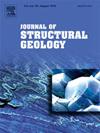龙门山断裂带深度地应力状态:来自汶川地震断裂带科学钻探工程2孔影像测井和岩心的证据
IF 2.9
2区 地球科学
Q2 GEOSCIENCES, MULTIDISCIPLINARY
引用次数: 0
摘要
龙门山断裂带作为青藏高原东缘的重要构造边界,其应力场特征对了解断裂带的运动学特征和地震活动性具有重要意义。最近的研究表明,断裂带的浅层应力场发生了显著的变化,特别是当地震破裂传播到浅层深度时,运动特征发生了明显的变化。为了研究断裂带内不同深度的应力状态,本研究通过汶川地震断裂带科学钻探工程2号孔(WFSD-2)钻孔壁成像测井和岩心样品,系统分析了映秀-北川断裂带的地应力场。结合前人的研究成果,确定了6个深度区间(424 ~ 569 m、958 ~ 1163 m、1271 ~ 1357 m、1523 ~ 1623 m、1870 ~ 2081 m、2112 ~ 2178 m),平均最大水平主应力方向分别为318°、301°、291°、306°、328°和190°,段间变化幅度为~ 20°。区域断层几何分析显示出明显的运动特征:1段为纯逆冲运动;2 ~ 4段为逆冲运动,具有右侧走滑分量;5 ~ 6段为逆冲运动,具有左旋走滑分量。综合已有研究,750 ~ 950 m和1300 ~ 1500 m深度段分别对应纯逆冲和右侧走滑逆冲机制,与汶川地震时映秀-北川断裂和神西沟断裂的同震滑动模式相匹配。这些随深度变化的差应力状态表现为断裂带的同震响应特征,是汶川地震中纵向非均质破裂过程的结果。这种震后应力构型反映了不同断裂段的运动调整,从根本上解释了2008年汶川地震中龙门山断裂带的结构复杂性和多期断裂特征。本文章由计算机程序翻译,如有差异,请以英文原文为准。
Depth-dependent in-situ stress state of the Longmen Shan fault Belt: Evidence from Wenchuan earthquake fault scientific drilling project Hole-2 image logs and core
The Longmen Shan Fault Belt, as a critical tectonic boundary along the eastern margin of the Tibetan Plateau, exhibits stress field characteristics that are important for understanding the kinematic features of the fault zone and its seismic activity. Recent studies have demonstrated significant variations in the shallow stress field of the fault zone, particularly when seismic ruptures propagate to shallow depths where the kinematic characteristics undergo marked changes. To investigate the stress states at different depths within the fault zone, this study systematically analyzed the in-situ stress field of the Yingxiu-Beichuan Fault through borehole wall image logs and core samples from the Wenchuan Earthquake Fault Scientific Drilling Project Hole 2 (WFSD-2). Combined with previous research findings, six depth intervals (424–569 m, 958–1163 m, 1271–1357 m, 1523–1623 m, 1870–2081 m, 2112–2178 m) were identified, with mean maximum horizontal principal stress orientations of 318°, 301°, 291°, 306°, 328°, and 190°, respectively, showing ∼20° inter-segment variations. Regional fault geometry analysis revealed distinct kinematic behaviors: Interval 1 exhibited pure thrust motion; Intervals 2–4 showed thrust-dominated motion with right-lateral strike-slip components; and Intervals 5–6 showed thrust motion with left-lateral strike-slip components. Integrated with existing studies, the 750–950 m and 1300–1500 m depth segments correspond to pure thrust and right-lateral strike-slip thrust regimes, respectively, matching the coseismic slip patterns of the Yingxiu-Beichuan Fault and Shenxigou Fault during the Wenchuan earthquake. These depth-dependent differential stress states, manifested as coseismic response features along the fault zone, result from the vertically heterogeneous rupture processes during the Wenchuan earthquake. This postsismic stress configuration reflects the kinematic adjustments of different fault segments, which fundamentally explains the structural complexity of the Longmen Shan Fault Belt and the multi-stage rupture characteristics observed in the 2008 Wenchuan earthquake.
求助全文
通过发布文献求助,成功后即可免费获取论文全文。
去求助
来源期刊

Journal of Structural Geology
地学-地球科学综合
CiteScore
6.00
自引率
19.40%
发文量
192
审稿时长
15.7 weeks
期刊介绍:
The Journal of Structural Geology publishes process-oriented investigations about structural geology using appropriate combinations of analog and digital field data, seismic reflection data, satellite-derived data, geometric analysis, kinematic analysis, laboratory experiments, computer visualizations, and analogue or numerical modelling on all scales. Contributions are encouraged to draw perspectives from rheology, rock mechanics, geophysics,metamorphism, sedimentology, petroleum geology, economic geology, geodynamics, planetary geology, tectonics and neotectonics to provide a more powerful understanding of deformation processes and systems. Given the visual nature of the discipline, supplementary materials that portray the data and analysis in 3-D or quasi 3-D manners, including the use of videos, and/or graphical abstracts can significantly strengthen the impact of contributions.
 求助内容:
求助内容: 应助结果提醒方式:
应助结果提醒方式:


